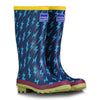
11 Marvellous Facts About Mud
In honour of all things muddy, we have delved deep into the history of mud to dig you up some weird and wonderful facts you never knew about mud.
Did you know that playing in mud makes us happier, or that mud is one of the oldest words in the English language?! Us either! Read on to find out more!

1) Playing in mud makes you happier
2) Ancient Egyptians used mud to build their houses
The bricks were made of mud and straw. The Egyptians would place the mixture into a rectangular mould to form it. Then they were left to dry in the sun.
3) Clay aka mud pottery dates back to 27,000 BC
Heat causes a chemical reaction that strengthens and hardens the mud (clay). Ceramic objects have been found, by archaeologists, all over the world. One Venus figurine dates back to about 27,000 BC!
4) Mud is an Old English word
Mud is an Old English word that has been with us since at least 1400. Other words for mud listed in the Oxford English Dictionary include slobber, slabber, slutch, lutulence, sloshiness and slushiness.
5) Volcanic mud is sold as moisturiser for hair
The mud penetrates the scalp, drawing out and eliminating impurities, which in turn help to invigorate and revitalize your hair.

6) Pigs bath in mud to stay cool
7) Mud pools are used by a variety of animals for a number of reasons
These animals often stir up the mud with their feet, horns or snouts before getting down for a roll.
8) Muddy architecture
Walls built of mud in China, Africa, India and even the cold wet climates of Northern Europe continue to provide shelter after several hundreds years of use.
9) Muddy wasps
The Mud Dauber wasp uses Mud to build its huts. They fly alone, not in a swarm.
10) Some snakes live in mud!
Mud snakes usually grow to a total length (including their tail) of 1-1.4m, with the record total length being over 2m!
11) Mud crabs
Mud crabs are found mainly in Western Australia from Shark Bay to the Northern Territory border. They like sheltered waters such as estuaries and mangrove areas. Can you delve deep into the mud and find any facts that we didn't find and add any more to the list?! If so, leave us a comment below!



















